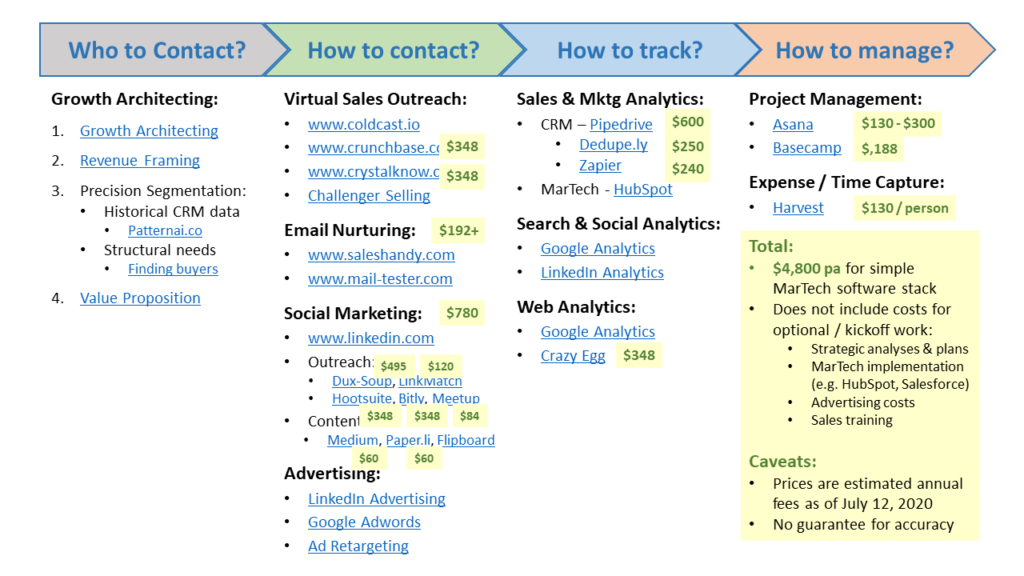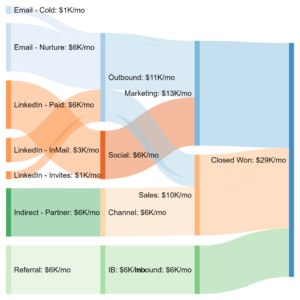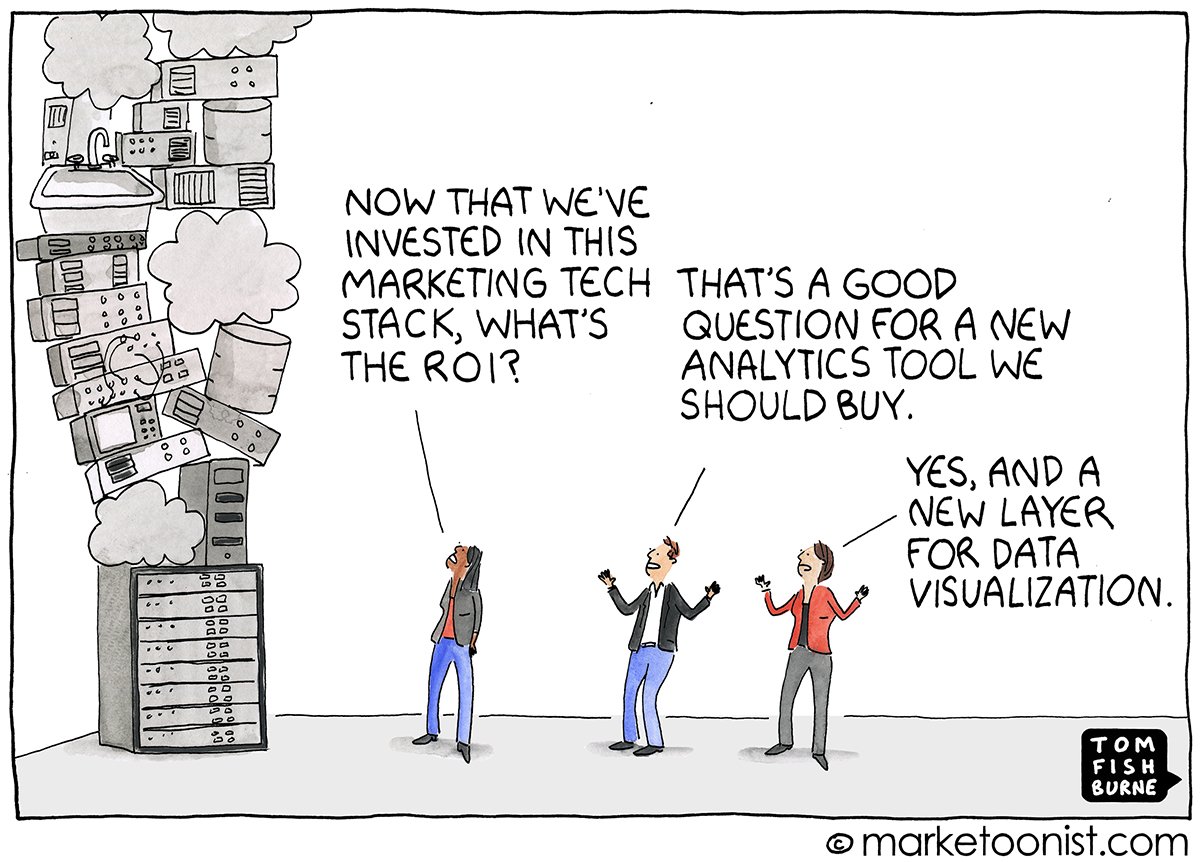Post-COVID Growth: Do more with less – Automate digital marketing with a simple, low $ MarTech stack
As businesses are looking for ways to mitigate the impact of the pandemic, sales and marketing budgets have shrunk and the uncertainty around meeting 2020 growth targets remains high. Leaders at startups are under higher pressure than their larger counterparts to generate more leads with less budget because they don’t have an established brand to fall back on.
Overcoming this challenge requires taking a novel approach to demand generation: We have tested and proven such an approach that can help your team do more with less. After you have read this post, you will have a reference blueprint to build a low-cost MarTech stack that gives you much of the power of a stack consisting of enterprise-grade apps like HubSpot, Marketo, and Salesforce … but literally at a fraction of the cost.
Digital selling is evolving:
COVID-19 has catalyzed many long due developments in B2B Marketing and Sales. In a time when customer preference for digital channels is only rising, the importance of digital marketing and selling has increased radically for B2B companies. Recently, HubSpot in its COVID-19 benchmark data report pointed out that digital marketing outreach, open rates, and database growth have increased since the start of the crisis. BCG is calling this the inflection point for digital sales and says that planning today to invest in the technologies and people needed to make that digital shift will pay off tomorrow.
If you are not already into digital marketing and selling or want to get better at it, our lean MarTech sample stack is a solid combination of affordable and easy to implement tools that can work seamlessly together at every stage of the B2B sales funnel. Here’s an easy to implement digital demand generation tool kit and plan with answers questions like “Who to target?”, “How to target”, “How to implement your low cost MarTech stack?”, and “How to track results?”
1) Who to target?
Fewer marketing dollars leave less room for error in the customer segments that you want to target. With AI-based tools like patternai.co, you can conduct precise segmentation for a fraction of the cost of a consulting engagement, and do so in real-time with automated updating of segmentation analyses. Better and rapid segmentation results in more targeted marketing which in turn leads to higher conversion rates and lower marketing costs.
2) How to target?
- ENGAGING: Now that sales calls, demos, and even trade shows have become virtual and will stay that way for quite some time, virtual sales meeting solutions like goldcast.io can help you engage current and prospective customers live online while you capture leads, engage with prospects, and track event effectiveness, all in real-time.
- CONNECTING: With our simple, lean MarTech stack we can connect with decision makers within your target businesses through omnichannel campaigns that combine LinkedIn ads and invites and email nurturing campaigns. Tools such as Dux-Soup and SalesHandy that have out-of-the-box integrations with a low cost CRM tool like Pipedrive are tailored to help small businesses find and connect with very precisely targeted audiences, as well as score and track the resulting leads.
- ADVERTISING: You can develop very targeted lead generation campaigns using tools like LinkedIn advertising and marketing. By integrating first LinkedIn and then Google advertising campaigns, you can target and then retarget exactly the right decision-makers and influencers within a business. These platforms also provide trackability that makes it simple to measure ROI.
3) How to implement your low cost MarTech stack?
So far, we have laid out all the elements you could be using to enable digital selling and marketing and how tracking and analyzing your campaigns can optimize your pipeline. Since you might be interested in more specific information about these applications and how to make them work, we added some more details here:
- Pipedrive, Dedupely: Pipedrive is an easy to implement and integrate sales CRM and pipeline management software that will do most of what an enterprise grade CRM does at a fraction of the cost. Dedupely can then be used to track and consolidate duplicate lead entries to create a high-quality database.
- LinkedIn Navigator, Crunchbase, Dux-Soup, LinkMatch, CrystalKnows and Sharetivity: LinkedIn is an important part of your B2B pipeline-building tool kit. The combination of LinkedIn Sales Navigator, Dux-Soup, and LinkMatch can automate the importing of your newly generated and old network contacts into your CRM tool (here we’re using Pipedrive). Sales Navigator supports an advanced lead search, makes lead and account recommendations, and helps you stay up to date with target company news. LinkMatch allows you to instantly see which LinkedIn profiles are in your CRM and which ones are not. You can then save profiles into your CRM and synchronize your CRM whenever a profile is updated. Dux-Soup can automate connecting with these profiles with personalized messages while collecting every profile’s contact information that can be plugged into your CRM system. How can you ensure that these profiles respond to you? CrystalKnows is an AI tool that you can use to scan a person’s LinkedIn profile (you have to be visiting their profile for CrytalKnows to run on it), assess their personality type, and get their optimized suggestions on the type of messages that are most likely to get them interested (e.g. to get them to take an appointment, to introduce yourself, etc.). A companion piece to CrytalKnows is Sharetivity which in a few seconds give you the loaded profile’s externally visible presence like published articles, company announcement, their social posts, etc., etc. While CrystalKnows tells you how to approach them, Sharetivity gives you material relevant to them that you can approach them with. Both together are great to strike up conversations with.
- SalesHandy, mail-tester.com: While the pipeline management and LinkedIn tools will ensure that the leads in your database are constantly updated, email nurturing will ensure that customers and prospects are consistently hearing from you. SalesHandy automates and tracks your email outreach for you. Set up email cadences to execute email outreach and nurture campaigns for your leads. A solid email campaign requires a clean database and mail-tester helps achieve that by evaluating the deliverability (aka “spammyness”) of your planned emails.
- Goldcast.io, Patternai.co, Challenger Selling: Real-time and automated segmentation using tools like Patternai.co can help businesses tailor their messages and offering to meet the needs of different customer segments. Goldcast.io is used to help set up memorable online sales events that are complete with networking sessions, group discussions, lead generation capabilities, and collects rich data for follow-up. Do your sales and marketing teams feel like a lot is changing very quickly? Challenger Selling can be taught via commercially available transformation programs that help your sales team change behaviors and develop engaging sales skills during a downturn while providing strong financial results for your organization.
- Hootsuite, Bitly, Medium, Paper.li, Flipboard, Meetup: Consistent and high-quality content marketing and social media marketing is essential for pipeline building. Good content facilitates conversion by building trust with and educating your leads and customers. Medium is a social publishing platform where you can post thought leadership content that can be discovered by your target audience. You can then use Bitly to identify which platforms give you most traction. Bitly helps you brand and customize links, track real-time click data, and identify top referrers and locations for all your links. A newsletter is a powerful way of creating awareness about your brand and products. Paper.li helps you curate already published content into newsletters which you can proactively send to your customers and prospects to build familiarity with your brand. Similarly, you can create a magazine using Flipboard and populate it with content from your brand’s blog, social media accounts, and website. If you want to engage with prospects and customers beyond blog posts, emails, and social media, Meetup may be a great marketing tool for you. Build groups that cater to the interests of your prospects and customers and engage them with virtual educational events. A great way to start using Meetup is to frequent other groups and see if the organizers will have you speak for five minutes about a topic in which you have expertise. To tie all of this content marketing and social media promotion together, use a social media management software like Hootsuite that helps you create, schedule, and analyze your content.
- Google Analytics, Crazy Egg: Now that you have a website and all this content out there, it is important to analyze the traction it is bringing you so that you can optimize your content and your promotion strategy based on real feedback. Google Analytics allows you to analyze your website performance and track audience behavior and demographics. How to make sense of all this data? Crazy Egg is a great tool for your MarTech stack that helps you visualize your Google Analytics and optimize your website through A/B testing.
- Asana, GetHarvest: Now that we have a fair bit to execute before we start generation leads through our lean MarTech stack, let’s talk about a project management tool. Asana can help your marketing and sales teams collaborate on plans, manage interdependencies and expectations, and prioritize their workflow. Keep track of the time and resources you invest in your endeavors via GetHarvest which is a time and expense tracking tool.
Here is a graphic showing how to implement this methodology using our lean, low-cost sample MarTech stack (pricing out at about $400 per month):

Figure 1 – Flowchart Outline of Low-cost Digital Marketing Stack
4) How to track?
Even the largest marketing budget will not yield optimum or any results unless you are tracking your progress and leveraging analytics:

- Quantitative Pipeline Modeling and Graphical Sankey Visualization: We have helped marketers across B2B startups analyze and optimize the return on their spend from all their lead generation sources. Our cohort models and Sankey diagrams (sample in Figure 2) help marketing teams identify the most effective demand generation sources so that they can optimize their spend while maximizing pipeline generation. The pipeline visualizations make it easy to see where marketing spend is warranted and where further optimization is needed. These visualizations are also great eye-candy in important meetings, e.g. with board or other exectives.
- Tracking KPIs: Once your growth pipeline has been modeled quantitatively, these quantifications can be turned into early warning systems by extracting “leading indicators” like activity metrics or KPIs (emails sent, calls made, impressions generated, etc.) that are occurring at the top of the funnel (TOFU). The “lagging indicators” or outcome metrics (i.e. bookings, pipeline generated, or SQLs produced) occur at the bottom of the funnel (BOFU). The latter is what everyone wants, but the benefit of modeling lies in knowing whether the TOFU KPIs measured now are sufficient to generate the outcome BOFU metrics three, six, or nine months from now.
Figure 2 – Sample Sankey Pipeline Graphic
If you would like to know more about how to implement our sample, low-cost MarTech stack and build a well-oiled demand generation machine with parts that talk to each other, please reach out to us on LinkedIn, Twitter, at info@marqetu.com, or call (001) (650) 727-0983.








